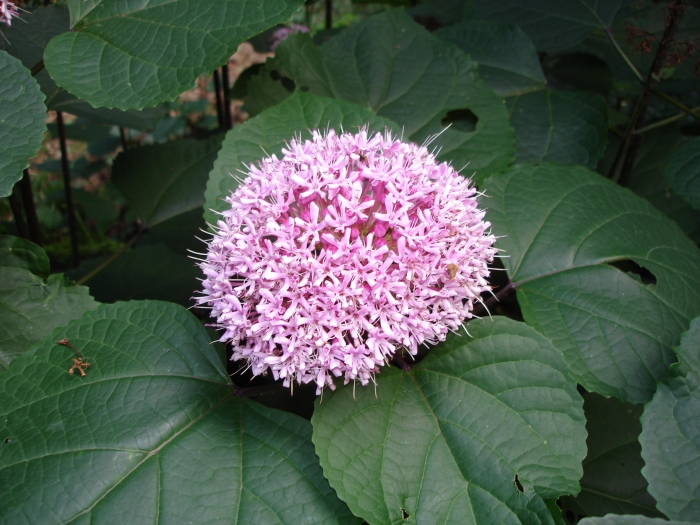Rose Glorybower
(Clerodendrum bungei)
Rose Glorybower (Clerodendrum bungei)
/
/

Xtreme77700
CC BY-SA 4.0
Image By:
Xtreme77700
Recorded By:
Copyright:
CC BY-SA 4.0
Copyright Notice:
Photo by: Xtreme77700 | License Type: CC BY-SA 4.0 | License URL: https://creativecommons.org/licenses/by-sa/4.0 | Uploader: Xtreme77700 | Publisher: Wikipedia Commons |

















































Estimated Native Range
Summary
Clerodendrum bungei, commonly known as Rose Glorybower, is a deciduous shrub native to woodland margins and scrub areas in China, including North Central, South Central, and Southeast. It typically grows to a height and width of 3-6 feet (0.9-1.8 meters), featuring a rounded form. The plant is adorned with large, ovate leaves and produces dense clusters of fragrant, tubular pink and red flowers from summer to fall, which are highly attractive to butterflies. The flowers are showy and provide a long-lasting display, but the crushed leaves emit an unpleasant odor. Rose Glorybower is noted for its suckering habit, which allows it to form spreading colonies, making it an effective choice for filling in large areas or creating informal hedges.
In cultivation, Rose Glorybower is appreciated for its fragrant flowers and ability to attract pollinators. It is suitable for urban planting, border planting, and as a specimen in gardens with ample space to accommodate its spreading nature. It thrives in full sun to part shade and requires medium amounts of water, adapting well to a variety of soil types with different drainage rates. In colder regions, such as Missouri in the United States, it is often grown in containers to be overwintered indoors. Gardeners should be aware of its rapid growth and potential to spread aggressively, which can be managed through regular pruning and by planting in confined spaces. It is potentially invasive outside its native range, so it is important to check local regulations before planting.CC BY-SA 4.0
In cultivation, Rose Glorybower is appreciated for its fragrant flowers and ability to attract pollinators. It is suitable for urban planting, border planting, and as a specimen in gardens with ample space to accommodate its spreading nature. It thrives in full sun to part shade and requires medium amounts of water, adapting well to a variety of soil types with different drainage rates. In colder regions, such as Missouri in the United States, it is often grown in containers to be overwintered indoors. Gardeners should be aware of its rapid growth and potential to spread aggressively, which can be managed through regular pruning and by planting in confined spaces. It is potentially invasive outside its native range, so it is important to check local regulations before planting.CC BY-SA 4.0
Plant Description
- Plant Type: Shrub
- Height: 3-6 feet
- Width: 3-6 feet
- Growth Rate: Moderate
- Flower Color: Pink
- Flowering Season: Summer, Fall
- Leaf Retention: Deciduous
Growth Requirements
- Sun: Full Sun, Part Shade
- Water: Medium
- Drainage: Medium
Common Uses
Bee Garden, Bird Garden, Butterfly Garden, Deer Resistant, Fragrant, Hummingbird Garden, Showy Flowers
Natural Habitat
native to woodland margins and scrub areas in China, including North Central, South Central, and Southeast
Other Names
Common Names: Strong-Scented Glorybower, Glory Flower, Mexican Hydrangea
Scientific Names: , Clerodendrum bungei, Clerodendrum foetidum, Clerodendrum fragrans var. foetidum, Volkameria bungei,
GBIF Accepted Name: Clerodendrum bungei Steud.